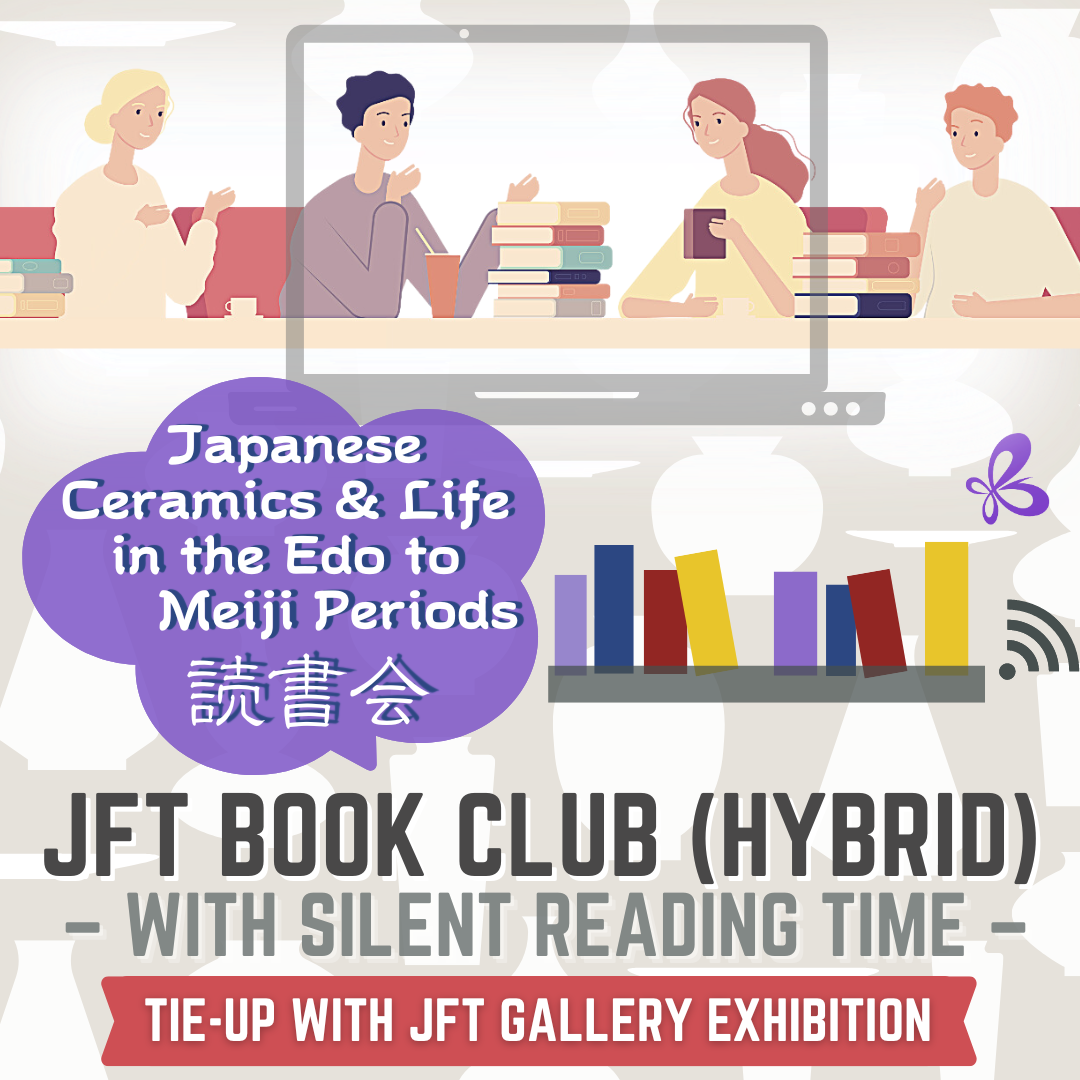JFT Book Club (Hybrid) – With Silent Reading Time – Japanese Ceramics & Life in the Edo to Meiji Periods

- This event has passed.
June 18th, 2024 @ 5:30 pm - 7:00 pm EDT
Details »

Oh and thank you for the amazing library catalogue. I have almost a year’s worth of books on my To Be Read list at the moment. Really appreciate it. Keep up the great work!.”—Johan
Please continue to check the JFT’s website and newsletters for future book club information.
 Enjoy the Simple Pleasure of Reading in Silence & Discover Japanese Arts and History!
Enjoy the Simple Pleasure of Reading in Silence & Discover Japanese Arts and History!
Join our next JFT Book Club (Hybrid) meeting where you are invited to read a book in silence in the library (or wherever you want if participating virtually) and engage in optional discussion with fellow book lovers interested in Japanese arts. Inspired by the JFT Gallery’s current exhibition, our upcoming book club meeting invites you to explore the beauty of Japanese ceramics and life from the Edo (1603-1868) to Meiji (1868-1912) periods.
No prior knowledge/preparation is required – indulge in the simple pleasure of reading in silence and engage in optional discussion to share your discoveries with fellow book and art lovers!
WHY JOIN JFT BOOK CLUB “WITH SILENT READING TIME”?
Many of us simply want more time to read but cannot squeeze the time in, as we have too many distractions and interruptions in our daily lives to concentrate on reading. JFT Book Club with Silent Reading Time offers a sanctuary to indulge in the simple pleasure of reading, surrounded by fellow book enthusiasts who share your love for literature. In addition, we provide an optional space for those who wish to connect and discuss their reading experiences with others. Engage in conversations at your comfort level and learn new perspectives from other book lovers from different cultural backgrounds that you wouldn’t gain from reading alone! It’s a safe space where your thoughts and impressions are valued, regardless of whether you choose to actively participate or quietly absorb the conversations around you. We welcome both seasoned book club members and first-time participants to discover the joy of silent reading without the pressures of finishing an assigned book on time and/or participating in mandatory discussions.
If you have any questions or concerns, please don’t hesitate to contact us in person, by phone, email, or via contact form.
HOW DOES THE UPCOMING JFT BOOK CLUB WORK?
- Once you register for the event, find a book to read based on the criteria listed in WHAT BOOK TO BRING? (see below) or from JFT Library’s collection.
- On the day of the event, we will meet via Zoom and in person at the Japan Foundation Toronto Library (2 Bloor St E #300, Toronto, ON M4W 1A8 Canada). *Click here to check how to get to our Library.
- We will start with a quick introduction & ice-breaking activity (*Light refreshments will be served for in-person participants)
- Participants will share their books and why they pick them up (2-3 minutes each)
- Silent Reading Time: Participants will read the book they bring or the one recommended by other participants anywhere in the library or wherever they want if participating virtually. If you join the book club in-person, you can check the JFT Gallery exhibition to compare the actual ceramics with what is written on the book you read.
- Optional Discussion Time: We will share what we have learned, what we think about the depictions of Japanese arts and culture during the Meiji and/or Edo periods, favourite moments from your chosen book, suggestions for next reads, etc.
*There is no right or wrong answer. Different perspectives make the discussion more fun and vibrant!
WHAT BOOK TO READ?
A book to bring can be either a physical book, ebook, or audiobook that meets the following criteria:
- Theme: The JFT Gallery Exhibition “From Edo to Meiji: Transformation of Japanese Ceramics” (i.e., fiction, nonfiction, or manga about Japanese Ceramics ; fiction, nonfiction, or manga portraying Japanese culture and society in Edo (1603-1867) and/or Meiji (1867-1912) periods)
- Language: Books can be written in any language (i.e. English, Japanese, French) but the book club meeting will be in English.
Check out JFT Library’s Book Lists to get ideas!
-
-
-
-
-
- Physical books on Japanese Ceramics and Culture & Life of the Edo/Meiji Period *UPDATED on Jun 11*
- Ebooks & audiobooks on Japanese Ceramics and society in Edo and/or Meiji periods *UPDATED on Jun 11*
-
-
-
-
You can either select a book from the JFT Library’s collection, or bring their own copy from home (can be a book not in JFT library collection if it meets the criteria above).
- If you would like to bring a book that is not in JFT library collection, please consult us in advance with the book information. (We may consider the book for future library acquisitions. )
*You can check whether the book is part of our collection by searching on our online catalogue (*to search physical & digital items) or JF Canada/USA Digital Library (*to search and read ebooks & audiobooks). Please contact us if you wish to confirm the availability with us.
To get a new JFT library card or to renew your existing card, please follow the instructions found here.
Related Programming
From Edo to Meiji: Transformation of Japanese Ceramics –Ceramic exhibition with ROM–
Now – Friday, June 28, 2024
In-Person Exhibition| Admission free
This special presentation of the collection of the Royal Ontario Museum, Toronto, reveals that Western modernization and the demand for exports influenced Japanese ceramics during the transitional period of the late Edo period to the Meiji period.
Now with an additional presentation, Kutani-ware Display with contributions from Toronto collectors, dedicated to the victims and survivors of the earthquake on January 1st, 2024, in Noto Peninsula, Ishikawa, Japan.
Royal Ontario Museum’s Online Collection
For those who are unable to visit JFT Gallery in person, some of the pieces in the exhibition are viewable online on the ROM’s Online Collection, which is accessible to everyone, anywhere in the world.
*List of ROM objects in the JFT Gallery exhibition (PDF with hyperlinks) *UPDATED on Jun 3*
 Living with Ceramics in Japan: From Edo to Meiji
Living with Ceramics in Japan: From Edo to Meiji
Thursday, June 13, 6:00PM – 7:30PM (ET)
Livestream Online Lecture | JFT Youtube Channel | Admission Free | Registration Required
This online talk will explore how people in Japan used ceramics during the Edo period, when the Tokugawa shogunate ruled the archipelago and the samurai held political and military dominance, and the Meiji period, when the emperor was symbolically restored to power and modernization transformed the nation.


























